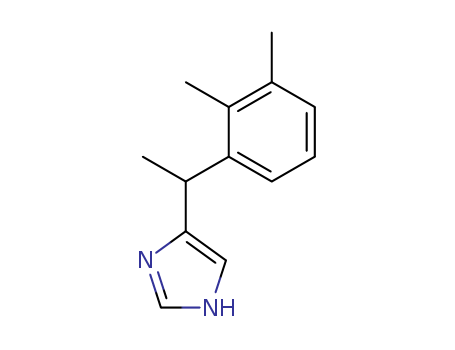Your Location:Home > Medetomidine


CasNo: 86347-14-0
MF: C13H16N2
|
Description |
Medetomidine is a synthetic compound used as a surgical anesthetic and analgesic. It is normally found as its hydrochloride salt, medetomidine hydrochloride. Medetomidine is an intravenously available alpha-2 adrenergic agonist. The drug has been developed by Orion Pharma. |
|
Indications |
Medetomidine Hydrochloride is indicated for use as a sedative and analgesic in dogs over 12 weeks of age to facilitate clinical examinations, clinical procedures, minor surgical procedures not requiring muscle relaxation, and minor dental procedures where intubation is not required. The IV route of administration is more efficacious for dental care. |
|
Side effects |
Bradycardia with occasional atrioventricular blocks will occur together with decreased respiratory rates. Body temperature is slightly or moderately decreased. Urination typically occurs during recovery at about 90 to 120 minutes posttreatment. In approximately 10% of treated dogs, occasional episodes of vomiting occur between 5 to 15 minutes posttreatment. An increase in blood glucose concentration is seen due to α2-adrenoreceptor-mediated inhibition of insulin secretion. |
|
Precautions |
In extremely nervous or excited dogs, levels of endogenous catecholamines are high due to the animal’s state of agitation. The pharmacological response elicited by α2-agonists (e.g., medetomidine) in such animals is often reduced, with depth and duration of sedative/analgesic effects ranging from slightly diminished to nonexistent. Highly agitated dogs should therefore be put at ease and allowed to rest quietly prior to receiving Medetomidine Hydrochloride. Allowing dogs to rest quietly for 10 to 15 minutes after injection may improve the response to Medetomidine Hydrochloride. In dogs not responding satisfactorily to treatment with Medetomidine Hydrochloride, repeat dosing is not recommended. |
InChI:InChI=1/C13H16N2/c1-9-5-4-6-12(10(9)2)11(3)13-7-14-8-15-13/h4-8,11H,1-3H3,(H,14,15)
The invention discloses a preparation me...
Medetomidine, a new potent $\text{alpha}_{2}-\text{agonist}$, in combination with the dissociative anesthetic ketamine, has been used to immobilize a variety of nondomestic mammals. Medetomidine alone induces sedation in a dose-dependent way, and complete immobilization has been achieved with high doses in semi-domesticated reindeer (Rangifer tarandus) and blue foxes (Alopex lagopus).
Medetomidine, (+/-)-4-[1-(2,3-dimethylphenyl)ethyl]-1H-imidazole, is a very potent, selective and specific full agonist at both pre- and postsynaptic alpha 2-adrenoceptors as demonstrated in several models both in vitro and in vivo. In receptor binding experiments the alpha 2/alpha 1 selectivity ratio of medetomidine is 1620 compared to 260, 220 and 160 for detomidine, clonidine and xylazine, respectively. The alpha 2-adrenoceptor activity of medetomidine resides predominantly in its d-enantiomer (dexmedetomidine). Medetomidine induces a dose-dependent decrease in the release and turnover of noradrenaline, dopamine and serotonin in the CNS as measured by changes in metabolite concentrations or using pharmacological intervention techniques.

methyllithium

(2,3-dimethylphenyl)(1H-imidazol-4-yl)methanone

4-<1-(2,3-dimethylphenyl)-1-hydroxyethyl>-1-(triphenylmethyl)imidazole

2,3-dimethylbromobenzene

(±)-4-[1-(2,3-dimethylphenyl)ethyl]-1H-imidazole hydrochloride

medetomidine hydrochloride

(S)-dexmedetomidine-L-(+)-tartrate

(rac)-4-[1-(2,3-dimethylphenyl)ethyl]-3H-imidazole oxalate